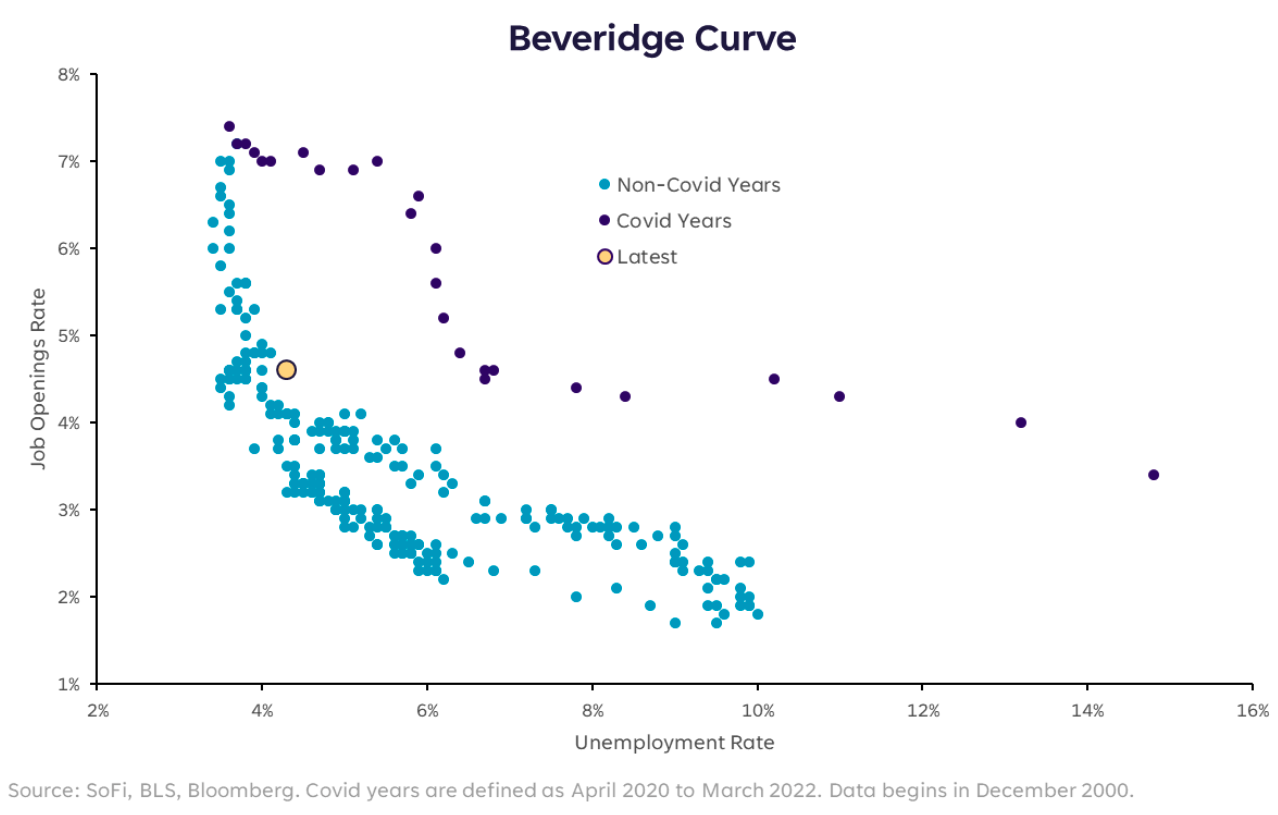Week Ahead on Wall Street: All About Jobs

Estimated reading time: 6 minutes
The Risks Are A-Changing
A key thing about our economy has changed recently, and it has to do with the Federal Reserve. The central bank has a dual mandate to keep prices stable and ensure maximum employment, and over the past years, the focus has really been on prices and inflation. Now that inflation has come down, the Fed is focusing its attention on the labor market. Unemployment has risen, job openings have fallen, and the way consumers feel about the labor market has worsened.
It’s important to contextualize things though. Worse does not mean all out bad. While the unemployment rate has risen nearly one percentage point, it’s still in the low 4%s, which is low relative to history. Job openings have fallen significantly, but there are still more unfilled positions than there are available workers. And while unemployment has risen, the rate of layoffs has remained stable at 1.1% (below the historical average of 1.4%).
How is this possible, you might ask: The answer is that labor force supply, boosted by immigration, has grown significantly while the rate businesses are hiring at has fallen. More workers taking longer to find work will push the unemployment rate higher.
It wouldn’t be economics if there weren’t some crosscurrents to sort through. One way economists distill all the labor data is by looking at the relationship between unemployment and job openings, also called the Beveridge curve.
In a typical economic cycle, the curve shows an inverse and nonlinear relationship: When unemployment is low, job openings tend to be very high as it gets tougher for businesses to find workers to hire. If labor demand changes in a situation like this, most of that shift will show up in job openings rather than unemployment (because it’s easier to change job postings than to lay people off). Conversely, when unemployment is high, businesses have an easier time finding workers to hire. If labor demand changes in these situations, that shift generally shows up in unemployment versus job openings. Here’s what it looks like for the U.S. economy.
When labor demand was very high in 2022, there were over two job openings per unemployed worker. Looking at the chart, the labor market was at the top-left end of the Beveridge curve. That contributed to the argument at the time that the Fed could cool the labor market without causing unemployment to rise too much. So far that’s exactly what has happened: The job openings rate has fallen from 7.4% in March 2022 to 4.6% as of July 2024, while the unemployment rate is still in relatively good shape.
The flipside is that as job openings have fallen, further declines in labor demand will start to show up in higher unemployment rates. We’ve moved down the Beveridge curve over the last two years with minimal layoffs, but we may be at a tipping point. It’s an open question if the Fed’s pivot is too little too late, and while this week’s bevy of jobs data won’t fully answer that question, it’ll help inform how investors think about the state of the U.S. economy.
Economic and Earnings Calendar
Monday
- September Dallas Fed Manufacturing Activity: This is the Dallas Fed’s survey of manufacturing executives in the region on business conditions and their outlook.
- Fedspeak: Fed Governor Michelle Bowman will give a speech on the economic outlook and monetary policy. Fed Chair Jerome Powell will give the luncheon address at a National Association for Business Economics conference.
- Earnings: Carnival (CCL)
Tuesday
- August Construction Spending: Construction data is a leading indicator of business activity.
- August Job Openings: A key measure of business demand for labor is the number of job openings, since reducing openings is easier and preferable to layoffs.
- September ISM Manufacturing PMI: This index from the Institute for Supply Management tracks how purchasing managers across the manufacturing sector feel about the business environment.
- September Dallas Fed Non-Manufacturing Activity: This is the Dallas Fed’s survey of services executives in the region on business conditions and their outlook.
- September Wards Total Vehicle Sales: Cars are a big ticket item for consumers, so underlying vehicle sales trends can help shine a light on demand for durable goods.
- Fedspeak: Atlanta Fed President Raphael Bostic will give opening remarks at the Technology-Enabled Disruption conference and moderate a conversation with Fed Governor Lisa Cook. Bostic, Richmond Fed President Tom Barkin, and Boston Fed President Susan Collins will participate in a moderated panel discussion at the Technology-Enabled Disruption.
- Earnings: Lamb Weston (LW), McCormick & Company (MKC), Nike (NKE), Paychex (PAYX)
Wednesday
- September ADP Employment Report: This survey, usually released a day or two before the official government jobs report, offers insight into private sector employment trends.
- Weekly Mortgage Applications: Mortgage activity gives insight on demand conditions in the housing market.
- Fedspeak: Cleveland Fed President Beth Hammack will give welcome remarks at the Fed’s 2024 Minorities in Banking Forum. St. Louis Fed President Alberto Musalem will give welcome remarks at the Community Banking Research Conference. Fed Governor Michelle Bowman will deliver the keynote speech at the Community Banking Research Conference. Richmond Fed President Tom Barkin will give a speech on the economy titled “Why Not Declare Victory?”.
- Earnings: Conagra Brands (CAG)
Thursday
- September Challenger Job Cuts: The firm Challenger, Gray & Christmas tracks the number of layoff announcements each month by sector.
- September S&P Global US PMIs: These indexes track how purchasing managers across different industries feel about the business environment.
- August Factory and Durable Goods Orders: These metrics give insight into underlying trends for leading cyclical indicators.
- September ISM Services PMI: This index from the Institute for Supply Management tracks how purchasing managers across different services industries feel about the business environment.
- Weekly Jobless Claims: This high frequency labor market data gives insight into filings for unemployment benefits. Jobless claims have continued to show a labor market that remains strong despite having cooled.
- Fedspeak: Minneapolis Fed President Neel Kashkari will moderate a discussion with Atlanta Fed President Raphael Bostic on the topic of an inclusive economy.
- Earnings: Constellation Brands (STZ)
Friday
- September Employment Situation Summary: This monthly blockbuster release from the Labor Department gives a comprehensive look at employment, wages, and hours worked in the previous month.
- Fedspeak: New York Fed President John Williams will deliver keynote remarks at a Council on Foreign Relations event. Fed Governor Christopher Waller will discuss the economic outlook.
Disclaimer
SoFi Securities (Hong Kong) Limited and its affiliates (SoFi HK) may post or share information and materials from time to time. They should not be regarded as an offer, solicitation, invitation, investment advice, recommendation to buy, sell or otherwise deal with any investment instrument or product in any jurisdictions. Keep in mind that investing involves risk, and past performance of an asset never guarantees future results or returns. It’s important for investors to consider their specific financial needs, goals, and risk profile before making an investment decision.
SoFi HK does not make any warranties about the completeness, reliability and accuracy of this information and will not be liable for any losses and/or damages in connection with the use of this information.
The information and materials may contain hyperlinks to other websites, we are not responsible for the content of any linked sites. The information and analysis provided through hyperlinks to third party websites, while believed to be accurate, cannot be guaranteed by SoFi HK. These links are provided for informational purposes and should not be viewed as an endorsement. The risk involved in using such hyperlinks shall be borne by the visitor and subject to any Terms of Use applicable to such access and use.
Any product, logos, brands, and other trademarks or images featured are the property of their respective trademark holders. These trademark holders are not affiliated with SoFi HK or its Affiliates. These trademark holders do not sponsor or endorse SoFi HK or any of its articles.
Without prior written approval of SoFi HK, the information/materials shall not be amended, duplicated, photocopied, transmitted, circulated, distributed or published in any manner, or be used for commercial or public purposes.

About SoFi Hong Kong
SoFi – Invest. Simple.
SoFi Hong Kong is the All-in-One Super App with stock trading, robo advisor and social features. Trade over 15,000 US and Hong Kong stocks in our SoFi App now.


